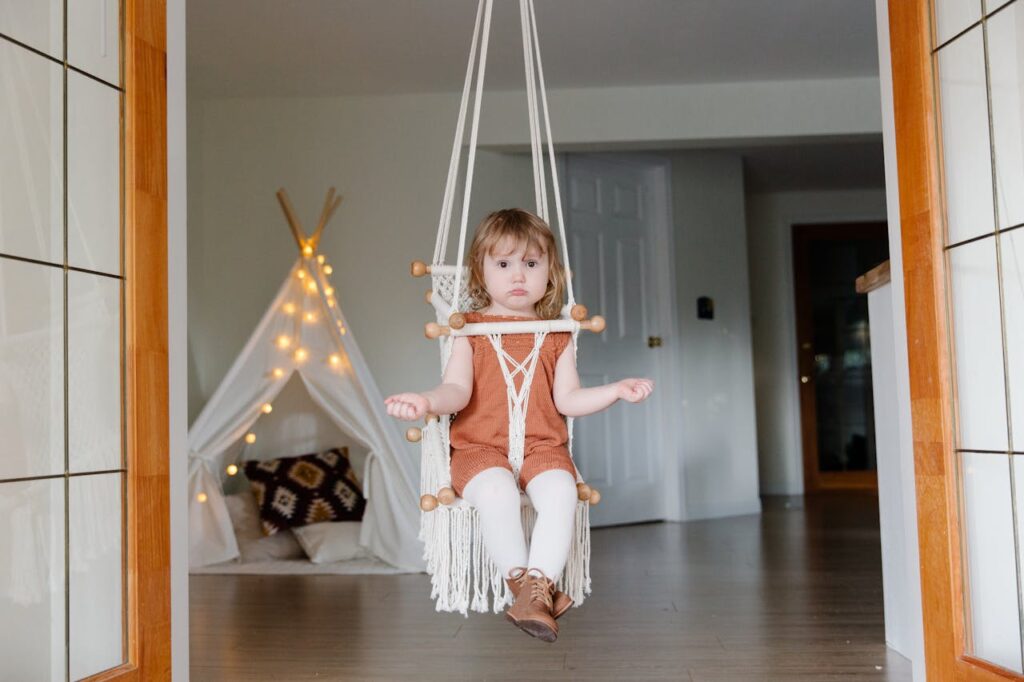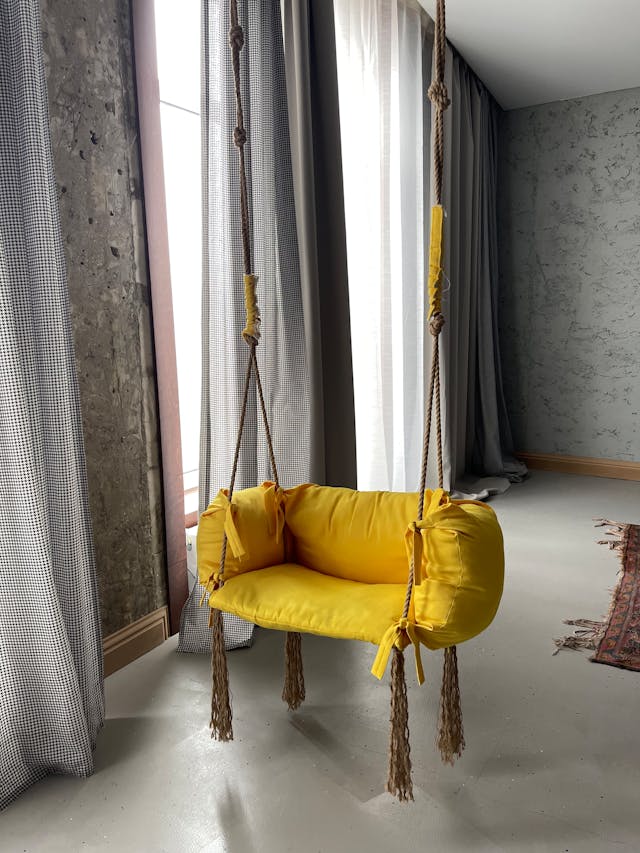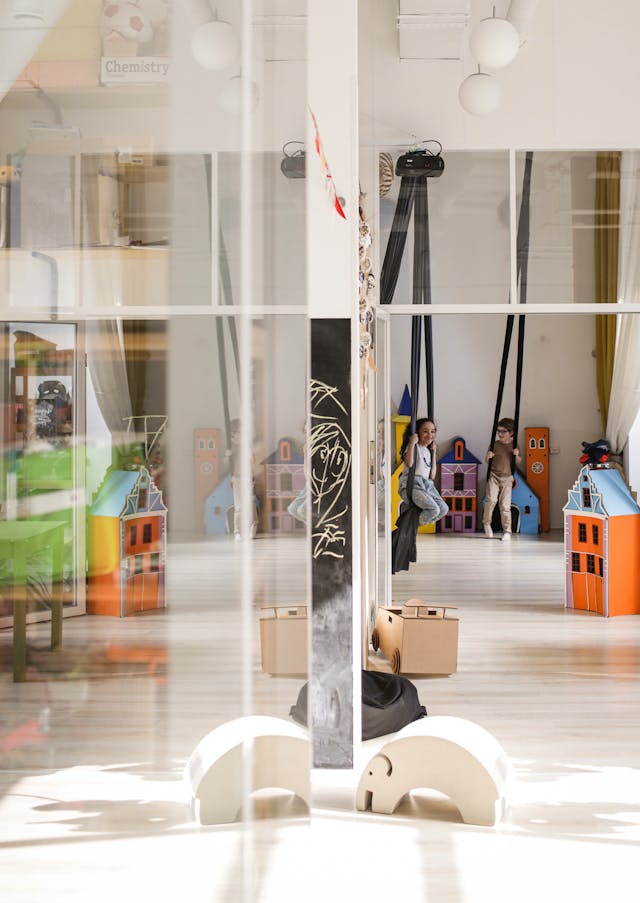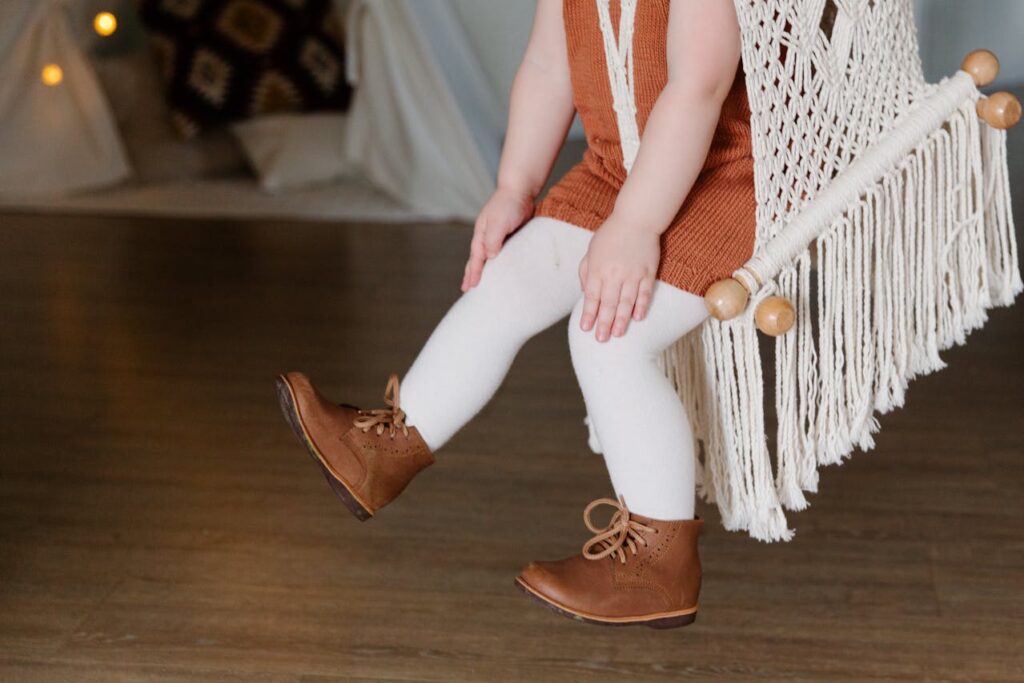Indoor swings are more than just fun. Join us as we delve into their benefits and how they foster several things for toddlers. It is said, “Happiness is a swing,” Ask any child on the playground, and they’ll quickly agree. Swinging has been practiced by humans for thousands of years; images of people on swings can be found in ancient Greek sculptures and art dating back to 1400 BC. American pioneers fastened swings with sticks, rope, and a tree. These makeshift swings were used as breaks while traveling west in covered wagons. But what is it about a wooden playset swing that holds our attention for hours at a time? Some may argue that it is an opportunity for social interaction, while others cite the numerous physical and developmental benefits of swinging.
Table of Contents
Why Do Kids Like To Swing?

To fully understand why children enjoy indoor swinging, we must first examine what occurs when they move back and forth. Indoor Swinging allows a child to experience a wide range of sensations. From the calming to-and-fro rhythm to the exhilaration of rapid movement through time and space. These experiences can be traced back to a baby in its mother’s womb, when the child first felt gravitational pull. Simply put, Indoor swinging stimulates our sensory systems, specifically our proprioception (awareness of the position and movement of the body in space and time) and vestibular (balance) systems.
Swinging stimulates the three semicircular canals in the inner ear, which respond to our body’s acceleration and movement in the diagonal, horizontal, and vertical planes. This stimulation is directly related to our vestibular system.
The physical activity of swinging, a three-dimensional movement through space, stimulates a child’s brain. Whether on a bucket swing, wooden swing, or belt swing, this movement activates that part of the brain, resulting in a rushing sensation. This enhances a child’s planning, language, and balance systems.
Swinging allows children to develop and maintain their proprioception system, which collects information from their joints and muscles. This information transmits signals to our central nervous system, forcing us to react.
What Are The Benefits Of Indoor Swing Sets and Toddler Swing Sets?

Swinging Is Excellent Physical Exercise
Swinging is, ultimately, exercise. It can burn over 200 calories per hour, making it a very effective training mode. Moreover, it does not exclusively build up muscles of tendons, joints, and ligaments. It also enhances muscle strength and control. One of the many ways a child can develop their core muscles is by swinging on a wooden swing. Developing the required force to maintain the swing chain or chord and swing enhances a child’s skill and grip strength.
Developing the strength required to hold on to the chain or rope of a swing helps a young person’s finger coordination and grip strength.
Not to mention improving your gross motor skills by running, jumping, and pumping your legs to gain height and momentum. Plus, swinging is the ideal low-impact exercise for children’s growing bodies.
Swinging Can Help A Child’s Brain Development
Swinging can significantly benefit young or developmentally challenged children by improving sensory integration. Sensory integration combines inner ear balance with spatial awareness. By stimulating these senses, the child’s brain gains the necessary practice in deciphering and organizing spatial information. They can lay the groundwork for complex behavior and learning as they grow.
Swinging Inspires Imagination And Creativity
When children play on swings, they can grow and expand their imaginations. They can make up stories about the pirate shipwreck they’re swinging to or where they’re coming from, such as an island that giant ants recently invaded! The possibilities for imaginative play on a swing are limitless – the sky’s the limit!
Swinging Improves A Child’s Social Development
Any time spent in unstructured settings, such as public playgrounds or a playset with swings, helps children improve their social skills. While out there, they learn patience, such as when waiting for a swing to become available. Alternatively, they create games for other toddler swing set users to make the activity more enjoyable. Swinging provides an excellent opportunity for children to develop social interaction skills as they build and live out their imaginative possibilities.
Swings Are Relaxing
Is it any surprise that children require relaxation, given the demands of school, extracurricular activities, and the impact of electronic devices? A wooden swing’s peaceful, simple back-and-forth motions help children unwind and relax. There is no right or wrong way to swing; simply pumping the legs allows children to move back and forth in the air gently.
Swinging Improves A Child’s Sleep
Numerous studies have shown that exercise improves children’s sleep. Toddler swing sets can provide excellent training and are incredibly relaxing. After an hour on the swing, the children are exhausted and ready to sleep.
Swinging Can Increase A Child’s Attention Span
Disengaging from a formal structure (e.g., class) and engaging in unstructured play allows children to refocus and prepare to re-engage in learning as the school day progresses. Swinging is one aspect of disengagement and unstructured play.
The swinging motion allows children to refocus their brains and engage in more structured activities. It is an excellent way for children to increase their attention span, and it is especially recommended for children who have been diagnosed with ADHD.
Are Indoor Swing Sets Safe?

The answer is simple: Yes! However, before you make that online purchase, you should follow a few guidelines to ensure swing set safety.
Supervision
It should go without saying, but it is worth repeating: make sure children who use any swing seat are supervised by a responsible adult. This is not only a fun way to spend time with your kids, but it also ensures proper use of the indoor swings.
One Person Per Chair
Part of a supervising role is ensuring that no more than one child sits on the swing seat at any time. This is simple if your child is using a baby swing. However, with a bucket swing or a belt swing, your child may prefer to sit on the lap of another. This can be extremely dangerous and may result in the swing breaking.
Establish A Swing Set Fall Zone
Several safety experts agree that establishing a six-foot zone in front and behind the swing will ensure everyone’s safety. Keeping this area free of hazards (such as other children, trees, fences, and other play equipment) will allow children to safely use the swings without fear of colliding with a nearby object or person.
Do Not Twist Chains Or Knot Ropes
Ensure your children understand the dangers of twisting chains or playing with the ropes connecting the swing seat to the apparatus. Twisting chains or ropes could cause them to weaken and break during flight, and children may choke or become entangled in them.
No Jumping While The Swing Is In Motion
When your child sees other children jumping off their swing seats in midair, it may appear to be fun. However, this can be extremely dangerous. If they eject themselves from a swing in midair, they risk twisting their ankle or wrist.
Conclusion

I bet you still remember the smell of wind and the feeling like you had more power than the world itself as you pedaled up and down and got a rush of adrenaline. The sunbeams shined on your face almost at the touch of the heavens. It is the magic and the feelings that a person can experience while swinging. In fact, “happiness is a swing.” If this phrase means you need to take action, what is preventing you from starting?


